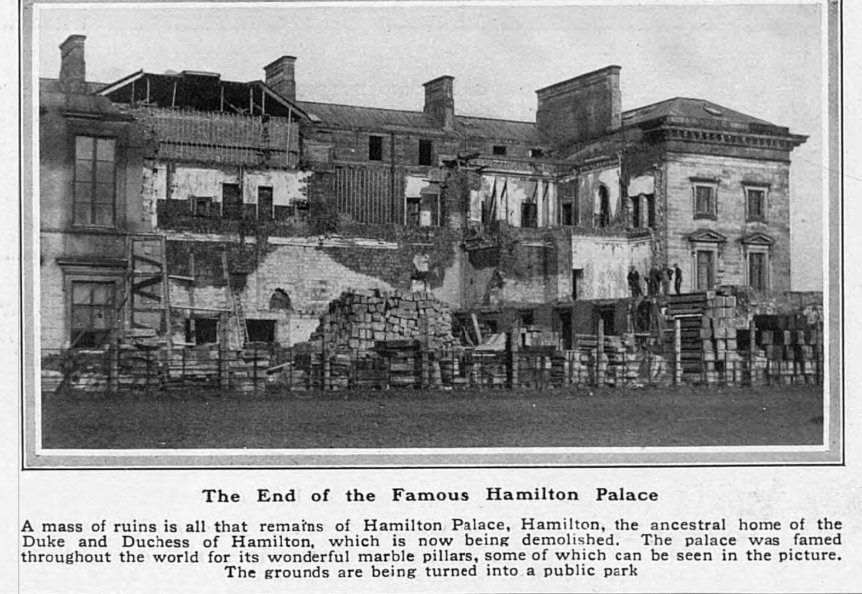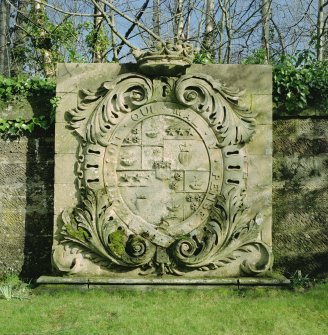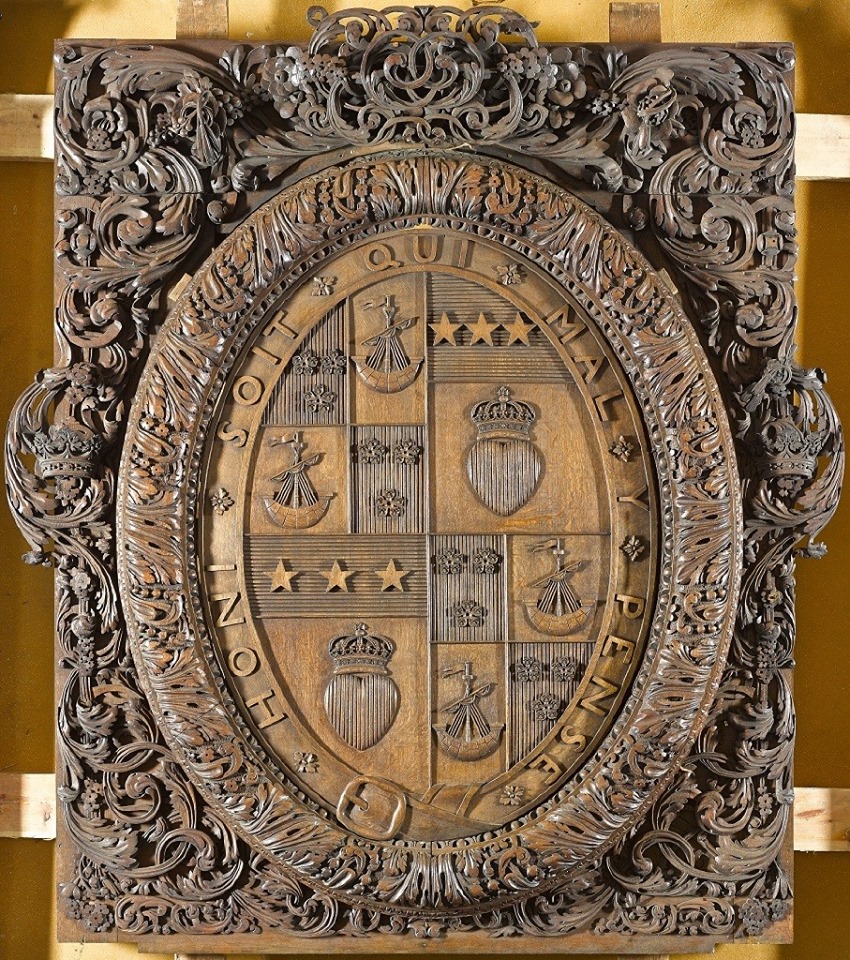Hamilton Palace
After
the death of James, the first Duke of Hamilton, the title passed to
his brother William. William died as a result of the wounds that he
received during the Battle of Worcester (1651) and the estate was
administered by Duchess Anne (1632-1716). She was a remarkable
administrator and the good fortune of the that time,
was entirely due to her, many of the Hamilton men proving to be
rather weak and ineffectual. The intention was to create a
'landscape folly', an important element within one of the most
ambitious landscaping schemes in Europe. The centrepiece was the
sumptuous Hamilton Palace with its 260-ft classical facade and an
interior that housed one of the finest art collections in Britain.
The south front of the palace was erected in 1695 by James Smith
and in 1707, as part of the ‘Great Design’ of Duchess Anne, it was
extensively redesigned and enlarged. She did, however, not live to
see the completion of her ideas. It was left to her grandson
James,
the 5th Duke of Hamilton, to engage the famous Scottish architect
William Adam in the 1740's, who completed the state-rooms which
included sumptuous stucco-work. The north front with it's grand
portico work was completed in 1842 by David Hamilton for
Alexander,
the 10th Duke (1767-1852).
The north front was 265 feet long
and 60 feet high, adorned with a splendid Corinthian portico of
monolithic columns 25 feet high and 10 feet in circumference,
modelled on the temple of Jupitor Stator at Rome.. The interior was
filled with art treasures, furniture, pictures, statutory, china and
glass - but in 1882 they were auctioned for £397,562, a notable
price for those days.
In addition to the priceless works of
art, there was a Great Gallery leading to the ambassadorial throne
from St Petersburg. The great black marble door of the hall
supported by two columns of green porphyry were unique in Europe.
The two porphyry columns which came from from the Church in St
Georgia in Viterbo had originally formed an ornament to the Basilica
di Semproneo, one of the most celebrated in Ancient Rome.
The
Great Hall was truly grand in its conception and its decoration of
carved beams supported by 16 fluted pillars with capitals, all of
polished black sandstone. Its floor was paved with Sienna and black
marble; the hall was dominated by a huge bronze bust of the Duke.
The steps, balustrades and rails of the Great Staircase were all of
pure black Galway marble. The landing was supported by two colossal
figures of bronze and the floor was of black marble, the walls of
polished sandstone.
It became the grandest seat in Scotland
and it's demise was a sad loss to Scottish architecture. Many years
of mining operations had caused dangerous subsidence and it's
condition was deemed to be unsafe. Ironically the Hamilton's wealth
was largely built on the mining of the rich coal seams under their
lands, but this proved to be the Palace's undoing as coal was
removed from underneath it.
Equally, large and ostentatious
houses had fallen from fashion and the cost of upkeep had become
prohibitive. It had been used as a naval hospital during WW1 and by
the time it was returned in 1919, it's fate was sealed. The Palace
was finally demolished in 1921 after another massive sale of it's
contents and fittings.
In the surrounding estate, the great
avenue of trees, the Hunting Lodge and the Duke's Mausoleum all
remain as a reminder of past grandeur.

The dismantling of Hamilton Palace
recalls the fate of Canons and Stowe; but the treasures
accumulated by "the princely Chandos," and his
great-great-grandson, the late Duke of Buckingham, bore no
comparison with the wonders of the palatial residence of the
Premier Duke of Scotland. How vividly and yet how painfully
does the scattering of these grand collections tell of the
instability of human things! The reckless extravagance of
one single inheritor, in a long line of succession, ofttimes
overthrows an ancient and illustrious house, just as a
hurricane levels in an hour the old oak that has stood for
ages safe against the storm. Thirty years have barely come
and gone since the death of Alexander, tenth Duke of
Hamilton and seventh Duke of Brandon, K.G., whose exquisite
taste and vast expenditure made his Scottish home, like the
Palace of the Medici, one of the noblest residences in
Europe; and now the magnificence of this glorious edifice
has passed away, leaving but a memory of what it once
contained.
Source: The Illustrated London News,
No.2254—Vol. LXXXI, Saturday, July 15, 1882, p.70 |
A wall from the the State Drawing Room has been re-assembled in
the National Museum of Scotland. Other artefacts can be found at
Barncluith House, including the coat of arms on the left.
The arms on the centre may have been placed in the National Museum
of Scotland. It too was removed from Hamilton Palace. It is an
oak overmantel carved by William Morgan in the 1680s.
The arms on the right are now in Low Parks Museum, in Hamilton.



Errors and Omissions
|
|
The Forum
|
|
What's new?
|
|
We are looking for your help to improve the accuracy of The Douglas
Archives.
If you spot errors, or omissions, then
please do let us know
Contributions
Many articles are stubs which would benefit from re-writing.
Can you help?
Copyright
You are not authorized to add this page or any images from this page
to Ancestry.com (or its subsidiaries) or other fee-paying sites
without our express permission and then, if given, only by including
our copyright and a URL link to the web site.
|
|
If you have met a brick wall
with your research, then posting a notice in the Douglas Archives
Forum may be the answer. Or, it may help you find the answer!
You may also be able to help others answer their queries.
Visit the
Douglas Archives Forum.
2 Minute Survey
To provide feedback on the website, please take a couple of
minutes to complete our
survey.
|
|
We try to keep everyone up to date with new entries, via our
What's New section on the
home page.
We also use
the Community
Network to keep researchers abreast of developments in the
Douglas Archives.
Help with costs
Maintaining the three sections of the site has its costs. Any
contribution the defray them is very welcome
Donate
Newsletter
If you would like to receive a very occasional newsletter -
Sign up!
|
|
|
|
|
|
|
|






